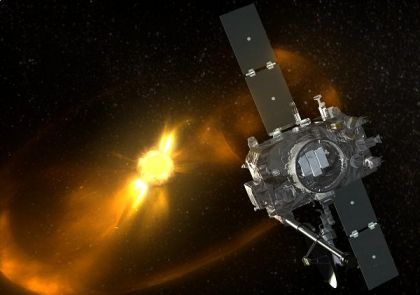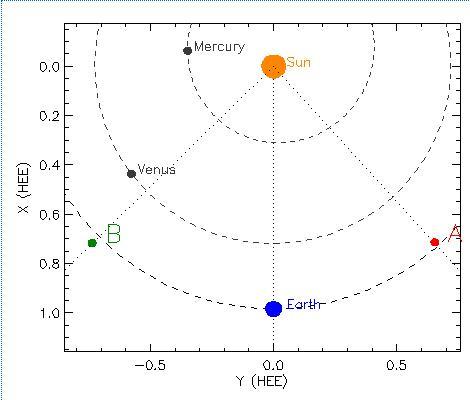In about two years, NASA's stereo spacecraft will arrive at a position from which they will see the backside of the sun * Although the sun rotates around an axis, it is very slow, so it is difficult to monitor in real time processes that have not yet reached the field of view or have already left it

NASA researchers have announced an event that will change our view of the Sun, and perhaps upgrade the field of solar physics for many years to come. On February 6, 2011, says Chris St. Kier of the Goddard Space Flight Center. On that day, two stereo spacecraft will move away at an angular distance of 180 degrees from each other and then it will be possible to photograph the entire sun for the first time in history, and not just the side facing the Earth at a given moment.
Two stereo spacecraft, each on a different side of the Sun near Earth's orbit, will solve a problem that has vexed astronomers for centuries: At any given moment, we can only see half of the Sun's surface. The sun rotates around its axis every 25 days, so over the course of a month you gradually see the whole sun. However, this month is not fast enough for many needs such as tracking sunspots. Sunspots can form, explode and reorganize within days; Holes in the mantle open and close, magnetic bubbles stretch and suddenly explode sending clouds of hot gas into the solar system. Half of this activity is hidden from view, which puts the space "weather" forecast in an uncomfortable position. How can you predict storms if you don't see them coming? Thus the belters cannot track the long-term evolution of sunspots or the dynamics of magnetic outbursts because they sink beyond the horizon at inconvenient times. Stirao's global view will put an end to these difficulties.
The global view of the sun is still about two years away from us, but the spacecraft are already transmitting images from beyond the horizon that the researchers and forecasters stick to their monitors. "This is an angle that until now has not been available to us," said scientist Lika Guthakurta, a member of the Stereo scientific team at NASA headquarters. "We now monitor over 270 degrees of the Sun's longitude, about three quarters of the star. "After all these years" she said with a smile, "we finally manage to see the dark side of the sun".
The Stereo spacecraft's journey to the dark side of the Sun began on October 25, 2006, when the twin spacecraft left Earth aboard a Delta 2 rocket. Outside the atmosphere, they separated and headed toward the Moon. After that, an event occurred for the first time in the history of space navigation. The moon acted as a gravitational traffic cop, directing the two spacecraft in opposite directions. Stereo A was moved to an orbit slightly distant from the Earth's orbit around the Sun while Stereo B was placed in an orbit slightly closer to the Sun than the Earth. Since then they have been moving away, and in the picture you can see where they are today.

Because of the way the sun rotates on its axis (counter-clockwise, in the image), B stereos are able to see sunspots and coronal holes before they reach the front of the sun visible from Earth, a benefit to forecasters.
"I know that NOAA's Space Weather Forecast Center is monitoring Stereo B closely," St-Cyr said. "This allows them to know what's coming."
Currently Stereo B enjoys a three-day lead over observers on Earth. This allows researchers to predict geomagnetic storms 72 hours earlier than before. On several occasions in late 2008, Stereo B observed coronal holes spewing solar wind before any other spacecraft did.
Saint-Cyr commented that radio amateurs could help NASA receive the images transmitted from stereo spacecraft. The busy deep space network downloads data from stereo spacecraft only three hours a day. That's enough time to download the previous day's data, but NASA would like to monitor the transmissions throughout the day. "So we're looking to set up a mini deep space network to stay in touch with stereo," said Bill Thompson, director of the Stereo Science Center at NASA's Goddard Center.
Both spacecraft transmit their data to Earth using radio beams in the X-BAND range. Anyone with a dish of 10 meters or more and a suitable receiver will be able to receive the signals. The data rate is very low, 500 bits per second and it takes 3-5 minutes to download a complete image.
So far, the miniature network already includes stations in the UK, France and Japan, and Thompson is looking forward to more: "NASA is encouraging owners of suitable antennas to contact the stereo team. We will be happy to work together with them and find out how they can join our network."
The spacecraft are among the most sophisticated spacecraft exploring the Sun. They are equipped with sensors that measure the speed, direction and composition of the solar wind; receivers that collect radio emissions from bursts and shock waves in the solar atmosphere; telescopes that photograph the surface of the sun and all the events that occur on it; and coronagraphs that monitor events in the sun's outer atmosphere. "We not only watch the sun but also feel, taste and listen to it." Guhtakorta summary
For information on the NASA website
On the same topic on the science website:

3 תגובות
"...thus the belters cannot follow the long-term evolution of the sunspots..."
They can help the officers…
Finally there will be something interesting to hear on the radio.. 🙂
Apple again?